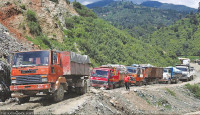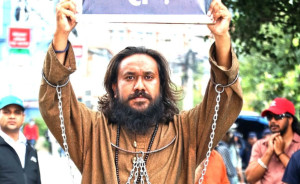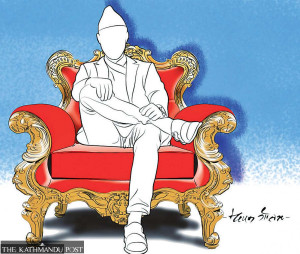Columns
Modi’s dangerous ‘double-engine’ slogan
It is a systematic attempt of the Bharatiya Janata Party to destroy the federal structure.
Ruhi Tewari
The ruling Bharatiya Janata Party (BJP) has unleashed a war cry for the Bihar assembly elections due later this year with its now favourite pitch—a ‘double-engine government’. Although this weapon to attract voters does have a certain sex appeal and might even work in swinging some votes towards the party, it is an affront to India’s federal structure and an ugly precedent to set in the country’s democratic polity.
In a rally in Bihar over the weekend, BJP leader and Home Minister Amit Shah appealed to the voters to vote for the ruling Janata Dal (United)-BJP alliance with a clear underlying message—how only a government led by Prime Minister Narendra Modi and Chief Minister Nitish Kumar can bring development to Bihar and sought to contrast this with his claims of a “jungle raj” under the rule of the Opposition Rashtriya Janata Dal (RJD) earlier.
What Shah meant was straightforward: Bihar can witness growth only if the BJP-led National Democratic Alliance (NDA), which is in power in the centre, is voted back to power in the state. This is a menacing and polarising missive by a party ruling the country for a third consecutive term. It not only raises questions regarding the justness of the country’s prime minister but also seeks to invalidate the very idea of an opposition in a federal democracy.
Among the many kinds of damage the BJP regime has done—from propping up the communal agenda and polarising the polity to destroying and misusing what are meant to be autonomous institutions—its ‘double-engine’ proclamation is among the most noxious in the long run.
BJP’s ‘double engine growth’ model
Shah’s Bihar pitch was hardly a one-off. This has been BJP’s messaging across state assembly elections since it has been in power for over a decade. Essentially, it has been urging voters to choose the BJP or NDA in states as well, claiming that only that can lead to true development.
It was first used during the 2014 Haryana and Maharashtra Assembly elections when the BJP stormed to power following the Lok Sabha polls. This messaging has been led from the front by the prime minister, who has used it during state elections ad nauseum—from Goa and Uttar Pradesh to West Bengal and Assam.
Using data from post-poll surveys conducted by the Centre for the Study of Developing Societies (CSDS) and Lokniti, an article in the Indian Express in 2022 concluded there was no noticeable correlation between the support for the idea among voters and the voting results. Even so, the BJP, nudged persistently by Modi, has made this its refrain, obviously sensing traction for it and perhaps taking a cue from its own internal feedback from the ground on how this idea does indeed appeal to voters.
The prime minister has not minced his words. He has gone so far as to claim that BJP’s double-engine government is “the guarantee of good governance”. Most recently, the party went to town underscoring its double-engine model ahead of and after its win in the election in the capital, where it decisively ousted the Aam Aadmi Party government.
Why the ‘double-engine’ pitch is nasty
This BJP, under the Modi-Shah combination, is known for its ‘whatever it takes’ approach to elections. In its 10 years in power, it has taught many lessons on how to fight elections, more often than not outwitting its opponents and convincingly winning over the electorate. But its killer instinct has also meant it doesn’t shy away from playing it foul whenever needed, and the double-engine government carrot that it dangles in front of voters is very much a leaf out of this textbook.
By making a strong pitch for voting for the same party in both the centre and the state as a prerequisite for development, Modi sends out two very problematic messages. One, despite being prime minister, he will give extra attention and benefits only to states where his party or alliance is in power. And two, he dismisses the idea of cooperative federalism, which rests on the central and state governments interacting constructively and working in tandem to improve governance.
These messages from the prime minister reek of hubris, injustice and a complete disrespect for democracy. It basically tells us that the party ruling the country is brazenly advocating a bias towards the states where it will be voted to power and, as a corollary, unabashedly issuing a subtle threat to those that don’t. It tries to render the opposition irrelevant by indicating that these parties should not be elected, not because the ruling party is better than them but because it wields more power.
Why should a double-engine government mean any more development for a state? Sure, the BJP has every right to claim it will govern a state better than its opponents if voted to power, just as every contesting party does. However, does it have the right to link that to it being in power in the centre? Is it fair or politically mature for it to hint at better cooperation between two BJP/NDA governments than between the centre and an opposition government in states? Essentially, the state government has to be in tow with the central government, never mind the spirit of democracy, federalism and collective governance.
This is particularly perturbing in a scenario where there are 75 Centrally Sponsored Schemes (schemes in which the centre provides the main chunk of funding) across key sectors—from rural welfare to women and child development, health, drinking water and sanitation and urban development, to name a few. There is so much power the centre holds and so much damage its bias can cause.
The messaging behind the whole double-engine government motto is discriminatory and sets a dangerous precedent in a democracy as large and diverse as India. Any country with a democratic spirit and federal structure ought to take a cue from this about what not to do when in power.
The BJP, intoxicated with power, has an unenviable record of attempting to crush any opposition, the most infamous being its use of law enforcement agencies. In the backdrop of its more brazen techniques, its seemingly harmless double-engine pitch can seem insignificant. It, however, is far more dangerous because wrapped in the subtlety of its message and the glamorous coinage and hidden beneath layers of positive spin, it is an unfortunate and systematic attempt to render the state governments powerless.
As Shah’s proclamations show, the BJP will make sure to use the double-engine government refrain persistently and consistently in the run-up to the Bihar elections. However, this goes against the very grain of PM Modi’s slogan of ‘Sabka Saath, Sabka Vikaas’ (together with all, development for all), and exposes the BJP’s real message—‘Hamara Saath, toh hi Vikaas’ (only if you support us will you grow).




 15.12°C Kathmandu
15.12°C Kathmandu















